Xuhai Xu
Towards a Science of Scaling Agent Systems
Dec 17, 2025Abstract:Agents, language model-based systems that are capable of reasoning, planning, and acting are becoming the dominant paradigm for real-world AI applications. Despite this widespread adoption, the principles that determine their performance remain underexplored. We address this by deriving quantitative scaling principles for agent systems. We first formalize a definition for agentic evaluation and characterize scaling laws as the interplay between agent quantity, coordination structure, model capability, and task properties. We evaluate this across four benchmarks: Finance-Agent, BrowseComp-Plus, PlanCraft, and Workbench. With five canonical agent architectures (Single-Agent and four Multi-Agent Systems: Independent, Centralized, Decentralized, Hybrid), instantiated across three LLM families, we perform a controlled evaluation spanning 180 configurations. We derive a predictive model using coordination metrics, that achieves cross-validated R^2=0.524, enabling prediction on unseen task domains. We identify three effects: (1) a tool-coordination trade-off: under fixed computational budgets, tool-heavy tasks suffer disproportionately from multi-agent overhead. (2) a capability saturation: coordination yields diminishing or negative returns once single-agent baselines exceed ~45%. (3) topology-dependent error amplification: independent agents amplify errors 17.2x, while centralized coordination contains this to 4.4x. Centralized coordination improves performance by 80.8% on parallelizable tasks, while decentralized coordination excels on web navigation (+9.2% vs. +0.2%). Yet for sequential reasoning tasks, every multi-agent variants degraded performance by 39-70%. The framework predicts the optimal coordination strategy for 87% of held-out configurations. Out-of-sample validation on GPT-5.2, achieves MAE=0.071 and confirms four of five scaling principles generalize to unseen frontier models.
Explainable AI as a Double-Edged Sword in Dermatology: The Impact on Clinicians versus The Public
Dec 14, 2025Abstract:Artificial intelligence (AI) is increasingly permeating healthcare, from physician assistants to consumer applications. Since AI algorithm's opacity challenges human interaction, explainable AI (XAI) addresses this by providing AI decision-making insight, but evidence suggests XAI can paradoxically induce over-reliance or bias. We present results from two large-scale experiments (623 lay people; 153 primary care physicians, PCPs) combining a fairness-based diagnosis AI model and different XAI explanations to examine how XAI assistance, particularly multimodal large language models (LLMs), influences diagnostic performance. AI assistance balanced across skin tones improved accuracy and reduced diagnostic disparities. However, LLM explanations yielded divergent effects: lay users showed higher automation bias - accuracy boosted when AI was correct, reduced when AI erred - while experienced PCPs remained resilient, benefiting irrespective of AI accuracy. Presenting AI suggestions first also led to worse outcomes when the AI was incorrect for both groups. These findings highlight XAI's varying impact based on expertise and timing, underscoring LLMs as a "double-edged sword" in medical AI and informing future human-AI collaborative system design.
A Multi-Stage Large Language Model Framework for Extracting Suicide-Related Social Determinants of Health
Aug 07, 2025Abstract:Background: Understanding social determinants of health (SDoH) factors contributing to suicide incidents is crucial for early intervention and prevention. However, data-driven approaches to this goal face challenges such as long-tailed factor distributions, analyzing pivotal stressors preceding suicide incidents, and limited model explainability. Methods: We present a multi-stage large language model framework to enhance SDoH factor extraction from unstructured text. Our approach was compared to other state-of-the-art language models (i.e., pre-trained BioBERT and GPT-3.5-turbo) and reasoning models (i.e., DeepSeek-R1). We also evaluated how the model's explanations help people annotate SDoH factors more quickly and accurately. The analysis included both automated comparisons and a pilot user study. Results: We show that our proposed framework demonstrated performance boosts in the overarching task of extracting SDoH factors and in the finer-grained tasks of retrieving relevant context. Additionally, we show that fine-tuning a smaller, task-specific model achieves comparable or better performance with reduced inference costs. The multi-stage design not only enhances extraction but also provides intermediate explanations, improving model explainability. Conclusions: Our approach improves both the accuracy and transparency of extracting suicide-related SDoH from unstructured texts. These advancements have the potential to support early identification of individuals at risk and inform more effective prevention strategies.
SensorLM: Learning the Language of Wearable Sensors
Jun 10, 2025Abstract:We present SensorLM, a family of sensor-language foundation models that enable wearable sensor data understanding with natural language. Despite its pervasive nature, aligning and interpreting sensor data with language remains challenging due to the lack of paired, richly annotated sensor-text descriptions in uncurated, real-world wearable data. We introduce a hierarchical caption generation pipeline designed to capture statistical, structural, and semantic information from sensor data. This approach enabled the curation of the largest sensor-language dataset to date, comprising over 59.7 million hours of data from more than 103,000 people. Furthermore, SensorLM extends prominent multimodal pretraining architectures (e.g., CLIP, CoCa) and recovers them as specific variants within a generic architecture. Extensive experiments on real-world tasks in human activity analysis and healthcare verify the superior performance of SensorLM over state-of-the-art in zero-shot recognition, few-shot learning, and cross-modal retrieval. SensorLM also demonstrates intriguing capabilities including scaling behaviors, label efficiency, sensor captioning, and zero-shot generalization to unseen tasks.
RADAR: Benchmarking Language Models on Imperfect Tabular Data
Jun 09, 2025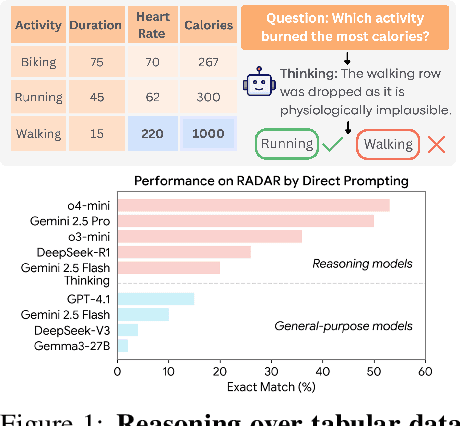

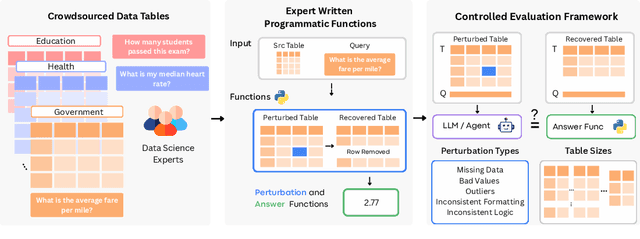
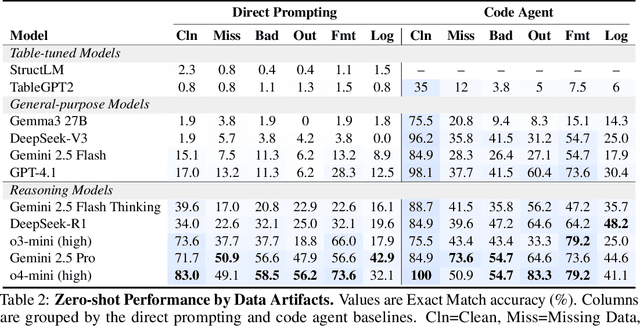
Abstract:Language models (LMs) are increasingly being deployed to perform autonomous data analyses. However, their data awareness -- the ability to recognize, reason over, and appropriately handle data artifacts such as missing values, outliers, and logical inconsistencies -- remains underexplored. These artifacts are especially common in real-world tabular data and, if mishandled, can significantly compromise the validity of analytical conclusions. To address this gap, we present RADAR, a benchmark for systematically evaluating data-aware reasoning on tabular data. We develop a framework to simulate data artifacts via programmatic perturbations to enable targeted evaluation of model behavior. RADAR comprises 2980 table query pairs, grounded in real-world data spanning 9 domains and 5 data artifact types. In addition to evaluating artifact handling, RADAR systematically varies table size to study how reasoning performance holds when increasing table size. Our evaluation reveals that, despite decent performance on tables without data artifacts, frontier models degrade significantly when data artifacts are introduced, exposing critical gaps in their capacity for robust, data-aware analysis. Designed to be flexible and extensible, RADAR supports diverse perturbation types and controllable table sizes, offering a valuable resource for advancing tabular reasoning.
LSM-2: Learning from Incomplete Wearable Sensor Data
Jun 05, 2025



Abstract:Foundation models, a cornerstone of recent advancements in machine learning, have predominantly thrived on complete and well-structured data. Wearable sensor data frequently suffers from significant missingness, posing a substantial challenge for self-supervised learning (SSL) models that typically assume complete data inputs. This paper introduces the second generation of Large Sensor Model (LSM-2) with Adaptive and Inherited Masking (AIM), a novel SSL approach that learns robust representations directly from incomplete data without requiring explicit imputation. AIM's core novelty lies in its use of learnable mask tokens to model both existing ("inherited") and artificially introduced missingness, enabling it to robustly handle fragmented real-world data during inference. Pre-trained on an extensive dataset of 40M hours of day-long multimodal sensor data, our LSM-2 with AIM achieves the best performance across a diverse range of tasks, including classification, regression and generative modeling. Furthermore, LSM-2 with AIM exhibits superior scaling performance, and critically, maintains high performance even under targeted missingness scenarios, reflecting clinically coherent patterns, such as the diagnostic value of nighttime biosignals for hypertension prediction. This makes AIM a more reliable choice for real-world wearable data applications.
Substance over Style: Evaluating Proactive Conversational Coaching Agents
Mar 25, 2025



Abstract:While NLP research has made strides in conversational tasks, many approaches focus on single-turn responses with well-defined objectives or evaluation criteria. In contrast, coaching presents unique challenges with initially undefined goals that evolve through multi-turn interactions, subjective evaluation criteria, mixed-initiative dialogue. In this work, we describe and implement five multi-turn coaching agents that exhibit distinct conversational styles, and evaluate them through a user study, collecting first-person feedback on 155 conversations. We find that users highly value core functionality, and that stylistic components in absence of core components are viewed negatively. By comparing user feedback with third-person evaluations from health experts and an LM, we reveal significant misalignment across evaluation approaches. Our findings provide insights into design and evaluation of conversational coaching agents and contribute toward improving human-centered NLP applications.
WatchGuardian: Enabling User-Defined Personalized Just-in-Time Intervention on Smartwatch
Feb 09, 2025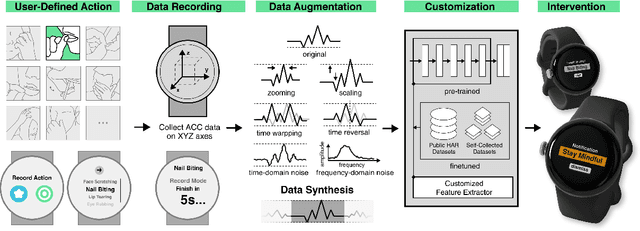

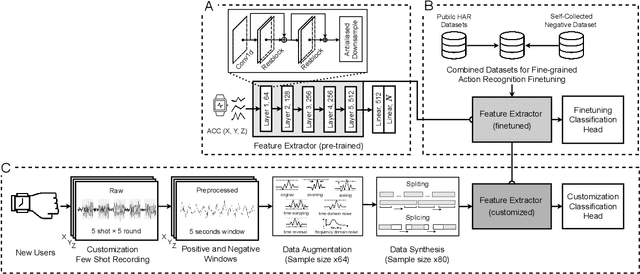
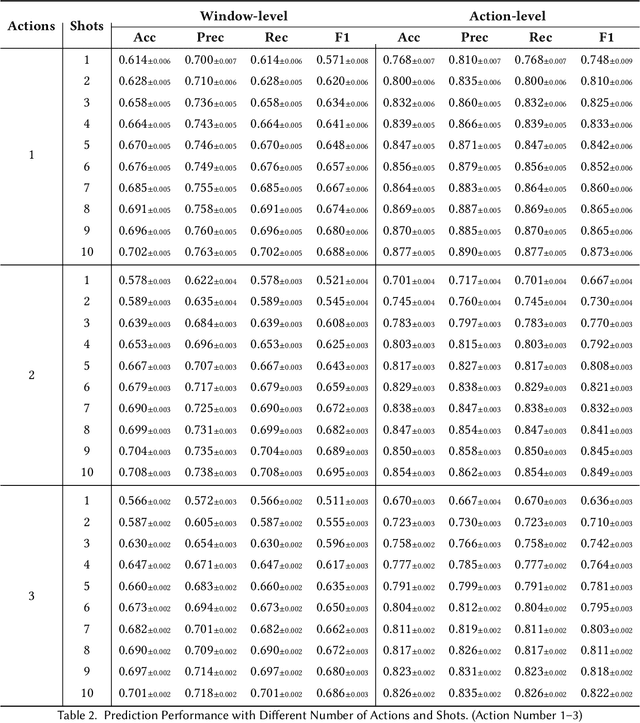
Abstract:While just-in-time interventions (JITIs) have effectively targeted common health behaviors, individuals often have unique needs to intervene in personal undesirable actions that can negatively affect physical, mental, and social well-being. We present WatchGuardian, a smartwatch-based JITI system that empowers users to define custom interventions for these personal actions with a small number of samples. For the model to detect new actions based on limited new data samples, we developed a few-shot learning pipeline that finetuned a pre-trained inertial measurement unit (IMU) model on public hand-gesture datasets. We then designed a data augmentation and synthesis process to train additional classification layers for customization. Our offline evaluation with 26 participants showed that with three, five, and ten examples, our approach achieved an average accuracy of 76.8%, 84.7%, and 87.7%, and an F1 score of 74.8%, 84.2%, and 87.2% We then conducted a four-hour intervention study to compare WatchGuardian against a rule-based intervention. Our results demonstrated that our system led to a significant reduction by 64.0 +- 22.6% in undesirable actions, substantially outperforming the baseline by 29.0%. Our findings underscore the effectiveness of a customizable, AI-driven JITI system for individuals in need of behavioral intervention in personal undesirable actions. We envision that our work can inspire broader applications of user-defined personalized intervention with advanced AI solutions.
Human-inspired Perspectives: A Survey on AI Long-term Memory
Nov 01, 2024


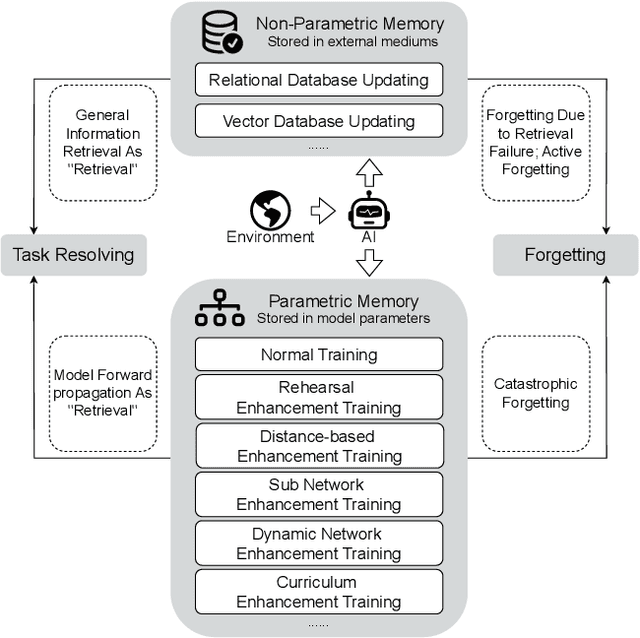
Abstract:With the rapid advancement of AI systems, their abilities to store, retrieve, and utilize information over the long term - referred to as long-term memory - have become increasingly significant. These capabilities are crucial for enhancing the performance of AI systems across a wide range of tasks. However, there is currently no comprehensive survey that systematically investigates AI's long-term memory capabilities, formulates a theoretical framework, and inspires the development of next-generation AI long-term memory systems. This paper begins by systematically introducing the mechanisms of human long-term memory, then explores AI long-term memory mechanisms, establishing a mapping between the two. Based on the mapping relationships identified, we extend the current cognitive architectures and propose the Cognitive Architecture of Self-Adaptive Long-term Memory (SALM). SALM provides a theoretical framework for the practice of AI long-term memory and holds potential for guiding the creation of next-generation long-term memory driven AI systems. Finally, we delve into the future directions and application prospects of AI long-term memory.
A Demonstration of Adaptive Collaboration of Large Language Models for Medical Decision-Making
Oct 31, 2024



Abstract:Medical Decision-Making (MDM) is a multi-faceted process that requires clinicians to assess complex multi-modal patient data patient, often collaboratively. Large Language Models (LLMs) promise to streamline this process by synthesizing vast medical knowledge and multi-modal health data. However, single-agent are often ill-suited for nuanced medical contexts requiring adaptable, collaborative problem-solving. Our MDAgents addresses this need by dynamically assigning collaboration structures to LLMs based on task complexity, mimicking real-world clinical collaboration and decision-making. This framework improves diagnostic accuracy and supports adaptive responses in complex, real-world medical scenarios, making it a valuable tool for clinicians in various healthcare settings, and at the same time, being more efficient in terms of computing cost than static multi-agent decision making methods.
 Add to Chrome
Add to Chrome Add to Firefox
Add to Firefox Add to Edge
Add to Edge